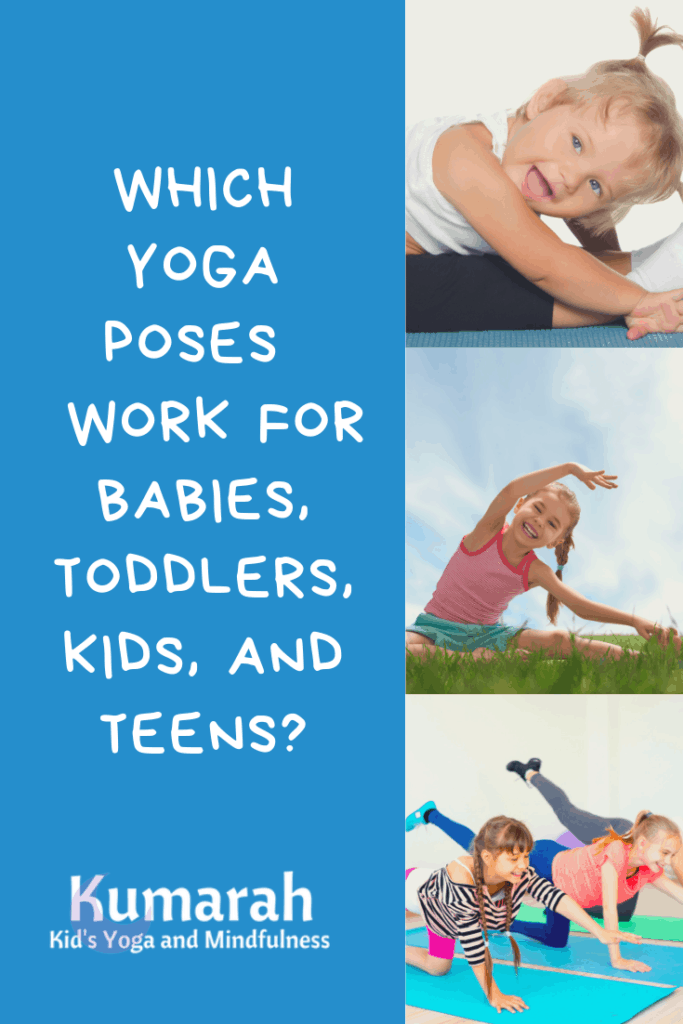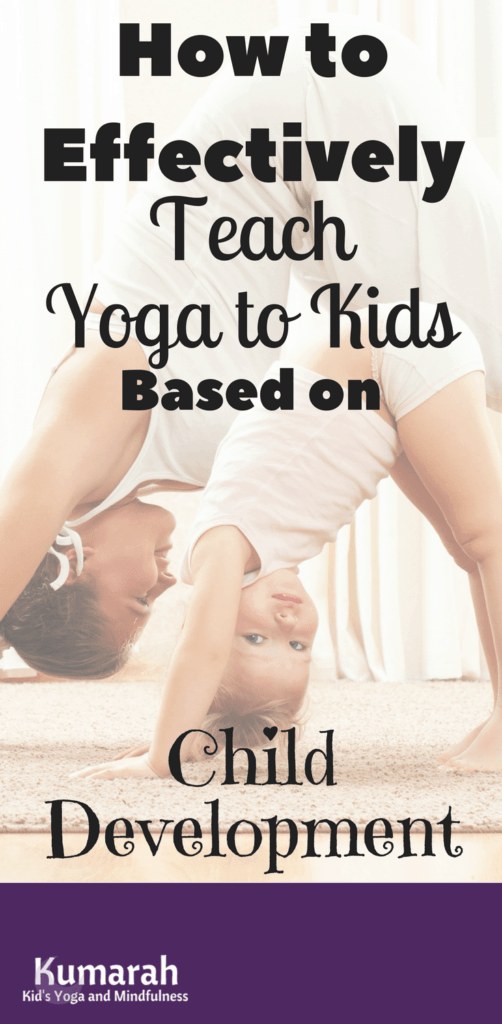Yoga is full of benefits for kids of all ages.
Yoga is good for kids’ spatial awareness and coordination. It increases their core strength and flexibility. It’s helpful in keeping them calm and learning about self-regulation.
Plus, it helps them focus in school, and be more active instead of just sitting all day.
So, when can you start teaching yoga to your kids? What age is the “right age” to introduce it?
In my opinion, you can never start too early! Kids of all ages, including those as young as babies and toddlers, can benefit from doing yoga poses with an adult or caregiver. And as soon as they can walk, they can start to work on other movement and coordination skills.
In order to teach yoga to young kids, it’s essential to know what they CAN do, and what they could be working on. Knowing a little about child development is hugely beneficial when you start working with kids.
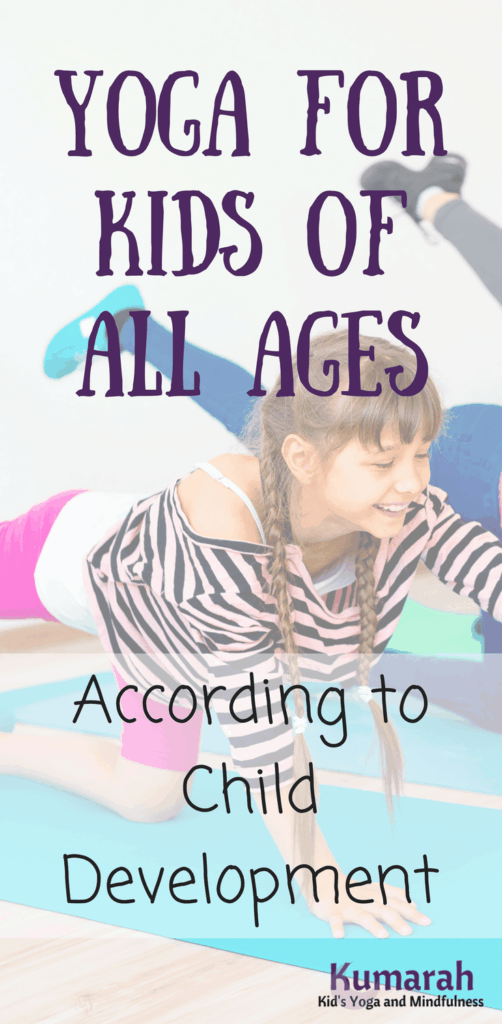
One resource that many teachers use to learn about child development as a teacher is a book called Yardsticks by Chip Wood. It is so helpful because it organizes kids’ development by social, emotional, physical, and academic capabilities.
Another good book that goes into good detail about child development is The Whole-Brain Child by Daniel J. Siegel. It is easy to read, and very enlightening in learning about what’s going on inside the head of those kiddos! Great for educators, parents, social workers, or anyone who is around kids of all ages.
If you are hoping to teach kids yoga classes, it’s also really important to take a kids yoga teacher training. (Here’s a helpful guide for choosing a program that’s right for you.)
One online course that is highly recommend is of course, Kumarah Yoga’s Ultimate Kids Yoga and Mindfulness Certification.
You’ll get tons of useful tips on how to teach yoga to kids of all ages, from toddlers to teens. The course has modules and lessons on anatomy and physiology for kids and teens, so you can learn even more about how to support them through different stages of their development.
Plus, you will learn tons of yoga poses, games, mindfulness activities, and lesson plans that work for kids of all ages, too!
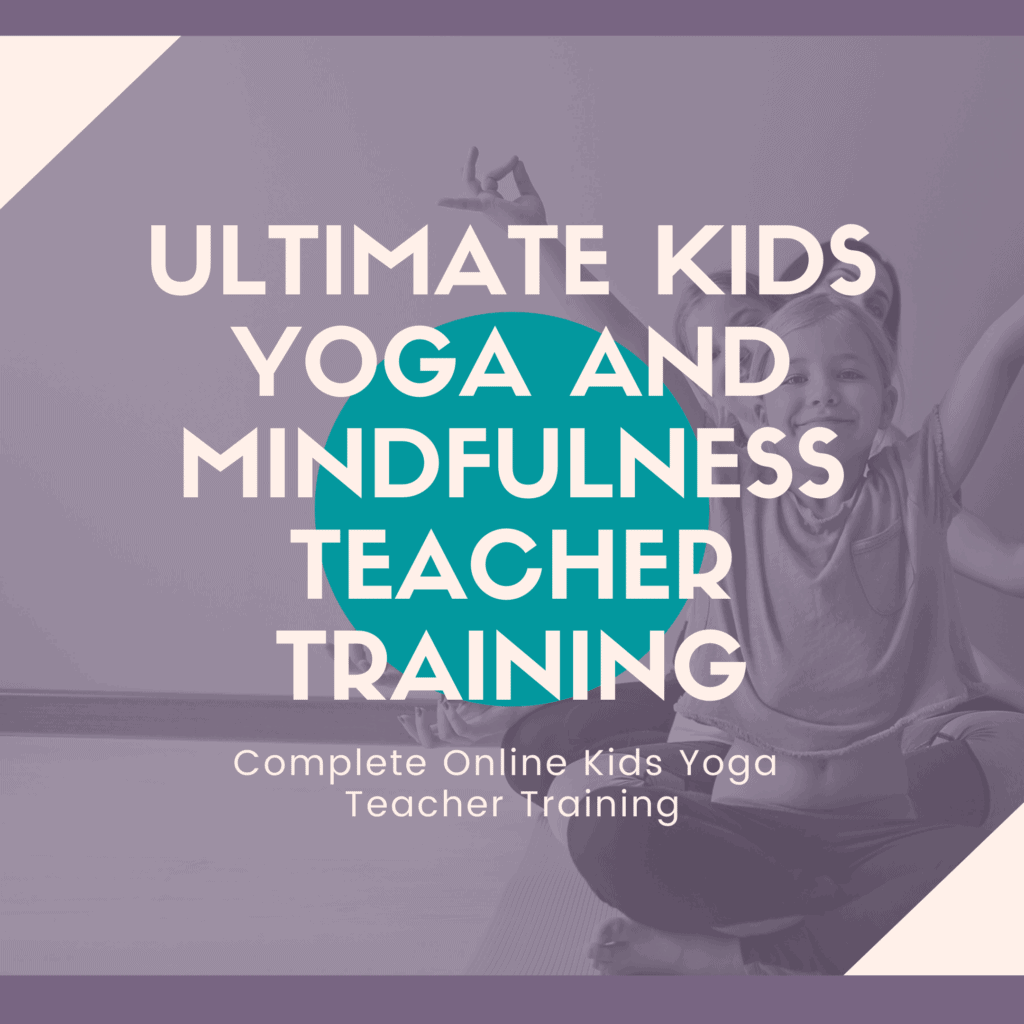
It comes with 5 smaller courses on teaching yoga, anatomy, physiology, classroom management, mindfulness for kids, ready-made lesson plans, and so much more! Click here to see everything you get in the training, instantly!
For the rundown of movement and physical development for kids and how to teach yoga to kids of all ages, keep reading here:
Yoga for Babies

Why?
Doing yoga with your baby has a lot to do with the benefits for you as a new mom or dad. It gets you moving in ways you maybe haven’t for awhile and builds flexibility and strength.
It gives you some “you time” while still spending time with your baby. You interact, move together, and do something a little different! Going to a class in the community also gives you the opportunity to bond with other new parents.
What do they learn?
Doing yoga with your baby is also really good for them in the sense that you are still bonding and engaging with them. It helps them with visual focus as they watch you come closer and get further away. It gives them a different spatial experience if you are holding them up or to the side in different ways.
Many classes that you go to with baby or that are taught online have soothing, repetitive movements as you interact. These are good for your baby in helping them relax and feel comforted. This book, Itsy Bitsy Yoga, has some fabulous pose ideas and tips and tricks for doing yoga with your new addition to the family.
What poses work best?
- Plank to down dog while your baby looks up from their back on the floor.
- Cobra, up dog, and locust, as your baby also spends some time on their tummy.
- Warrior 2 with your baby on your leg, then go to goddess pose, then the other side. Be careful as you balance!
- Chair pose while you lift your baby from your knees to way up high! Great for quads, arms, and shoulders.
- Cat and cow as your baby start to push up from the floor and maybe starts to crawl as well!
Yoga for Toddlers
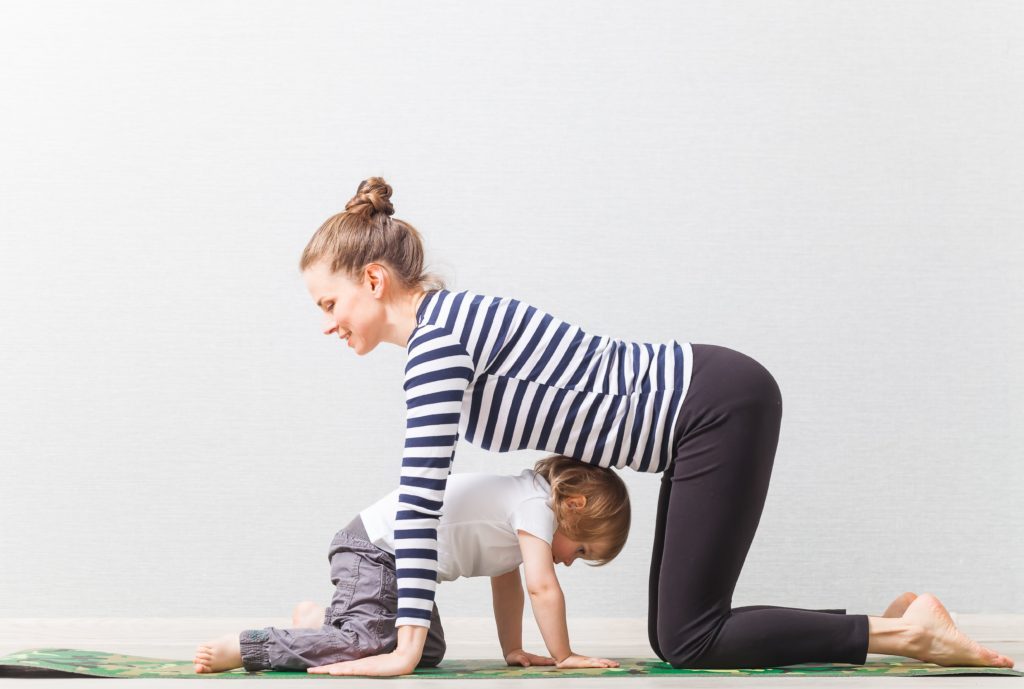
Why?
Toddlers and preschoolers are very good at copying. But they are starting to navigate the world in different ways and social interactions are sometimes tricky.
Doing yoga with toddlers gives them an appropriate way to move and navigate physically in their space. It also helps them start to interact with others if they are in a class.
They begin to notice others in relation to themselves. It also is PERFECT for working on new vocabulary about body parts, prepositions, and animals!
What do they learn?
SO MUCH! Toddlers will start to learn basic cues like “touch”, “turn,” “move,” “bend,” “reach,” “twist,” “over,” “under,” and more.
Toddlers will be practicing visual copying and body awareness with yoga. They can copy what you do, acting like a true mirror in the best way they can.
They’ll learn spatial awareness of their surroundings. They can fall and bump into things and start to learn the limits of where they are and what they can do safely.
What poses work best?
- Down dog is the best for many reasons. They can wiggle their puppy tails, lift their puppy leg, and all sorts of fun things.
- Cat and cow are easy as well and teaches them about their spinal movements.
- Standing mountain is good for reaching, then adding reach to one side or the other.
- Star pose with arms and legs out wide helps them with balance.
- Chair pose is good for beginning balances as well.
- Seated forward fold is easy, as well as wide-legged forward fold. From here you can have them reach one way and the other.
- Frog pose is another great one and they can start to hop around, too.
- Jumping, hopping, galloping, bouncing, and wiggling are always great actions to add.
- Standing on one leg is sometimes possible and can be fun to practice how to fall safely!
Laying down for savasana is sometimes a possibility for about 30 seconds with 2-year-olds, and longer as they are age 3 and approaching 4. However, if you do this before nap or bedtime you may be able to prep them for sleep by “practicing” sleeping pose.
As always, modeling it yourself is key. Or you can read this Good Night Yoga book with them that is my absolute favorite.
Read this additional two articles on toddler yoga here:
Check out this fun video with easy toddler yoga poses to do with your little one!
Yoga for Kids Ages 4-6
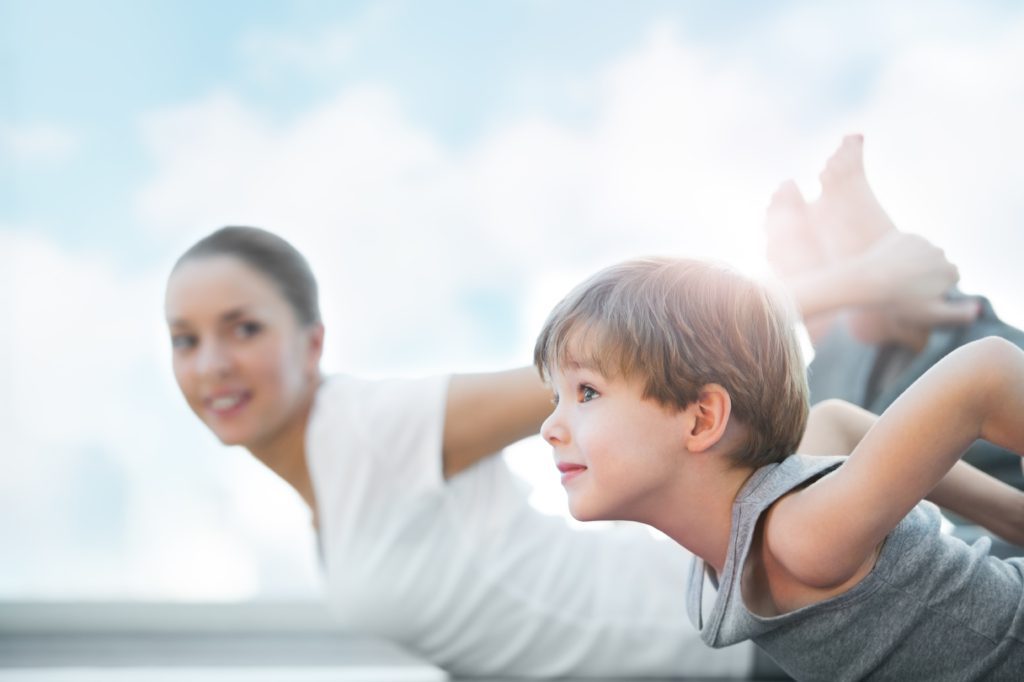
Why?
Kids this age have SO much imagination, and for this reason, it is my favorite age group for teaching yoga. They love hearing stories, and the number of poses you can do with them increases very quickly as their coordination, balance, and visual copying skills improve.
It’s a crucial age for teaching about physical activity and helping them stay motivated to have fun and move. They love to play and invent new poses, and they can start to be practicing movement and poses on their own, with visuals, videos, or books.
Here are some great yoga books to try with kids this age.
What do they learn?
Kindergarten age kids are starting to learn more about the sides of their body, right and left, opposites versus same sides. Cross-body movements are super helpful and will help them connect the two sides of the brain for better focus.
They learn more about body parts as they are able to start isolating movements to specific areas (not always super accurately): bend your knees, rotate your hands, swing your arms, shake your hips, move your spine, roll your shoulders, reach for your ankles, etc.
Kids ages 4-6 can follow specific movement directions to learn about directionality, physical space, and types of movement. For example, say twist your upper body quickly or move your leg slowly.
A lot of this is done with the help of animal movements: move like a cheetah, walk like a turtle, crawl like a crab, etc.
Check out my post on Animal Yoga ABC’s here!
They can start to balance better and love to try new balances. Hopping is usually part of this, but I encourage them to put their foot back down instead of hopping and try again.
What poses work best?
- Anything animal related. They love to sound like animals, move like animals, and then start to “pose” like specific animals. Many of their made-up poses end up looking similar to one another (think: crawling) but the imagination and intent is the important part!
- Movement versus pose: as I stated we do, “move like a _____” a lot, and then I teach them “pose like a _______,” which is the start of introducing specific poses. Once they understand that poses are supposed to be still, you can start teaching more difficult ones.
- Favorite poses are: down dog, cat, cow, cobra (snake), crocodile, shark (locust), lizard (runner’s lunge), frog, kangaroo (chair), flamingo (basic dancer pose), mountain, star, horse (goddess), volcano (goddess to star), triangle.
Savasana is a definite option for kids this age. You can let them hold a Beanie Baby or small stuffed animal on their tummy to practice belly breathing. Once they practice enough, kiddos can lay still with practice for a good 2-5 minutes.
Here’s another good article with tons of information on Yoga for Kindergarten aged kiddos.
Yoga for Kids Ages 7-8
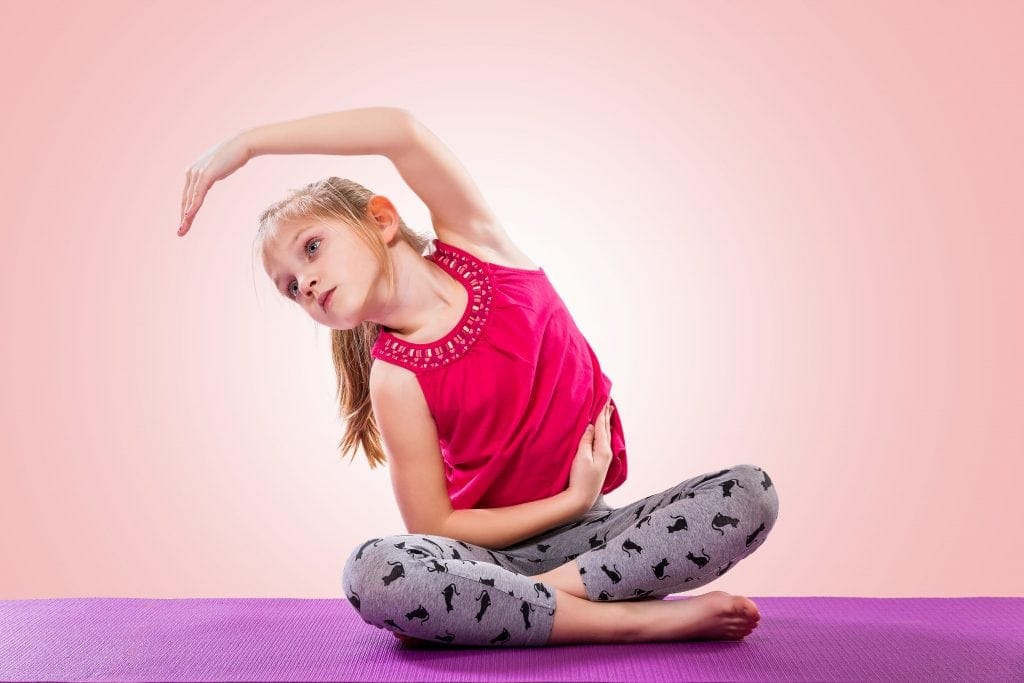
Why?
This is a wonderful age to start letting kiddos have more autonomy with yoga. You can teach them Sun Salutation B, standing poses, and balances.
This is also a great age to let them create some new poses. They like to explore the limits of their bodies, try new things, have challenges, and be creative.
At this age, they are better coordinated and balanced, and they don’t yet have too much embarrassment or shyness (usually). They want to play and have fun while learning and staying active.
This is also a great age to work on storytelling with them.
What do they learn?
Kids ages 7-8 have a greater ability to copy movements more accurately. So they will be able to bend one knee at a time, reach the correct arm forward or back, and therefore get more benefits of the actual poses.
This age group also is able to invent more complicated poses based on shapes of animals or things in their environment. They try new things pretty readily and are able to follow more complex directions involving several steps.
At this age, kids are able to verbalize better how their body feels and why. I frequently will talk about how I’m feeling as I do different poses and movements. That encourages them to think about and notice how poses may help them as well.
If they come to me with bodily complains (my tummy hurts, my back hurts…) we will dive right into poses that can help us stretch and strengthen those areas. They love learning solutions to these problems and how they can use them in other areas of their lives.
What poses work best?
- Almost all of them! They still love animal poses a lot, but they start to like hearing the “real names” of the poses too.
- It might be a good idea stop teaching cat/cow around this age because sticking your butt out can be too silly or vulnerable at this age. Shoulder stand and plow are also harder to teach because it is hard on their neck if they move their head, which they WILL do.
- You can start explaining warrior 1 vs warrior 2 as they are able to better follow directions about straight leg/bent leg
- We also add in extended side angle and reverse warrior to our Sun Salutation
- Many kids love challenging themselves with the splits so we do dragon (low lunge with knee down) to [half-]monkey (hips back and front leg straight) a LOT.
- Balances become more attainable at this age, so we do tree pose a lot. We also add a basic warrior 3 or airplane pose.
Savasana is great for them at this age, and with a beanie baby and a guided relaxation, my kiddos can lay there for about 5 minutes every class.
They are also great at practicing lots of breathing exercising, like the ones in this post here.
Here’s a fun yoga storytelling adventure that works great for students aged 7-8.
Yoga for Preteens Ages 9-11
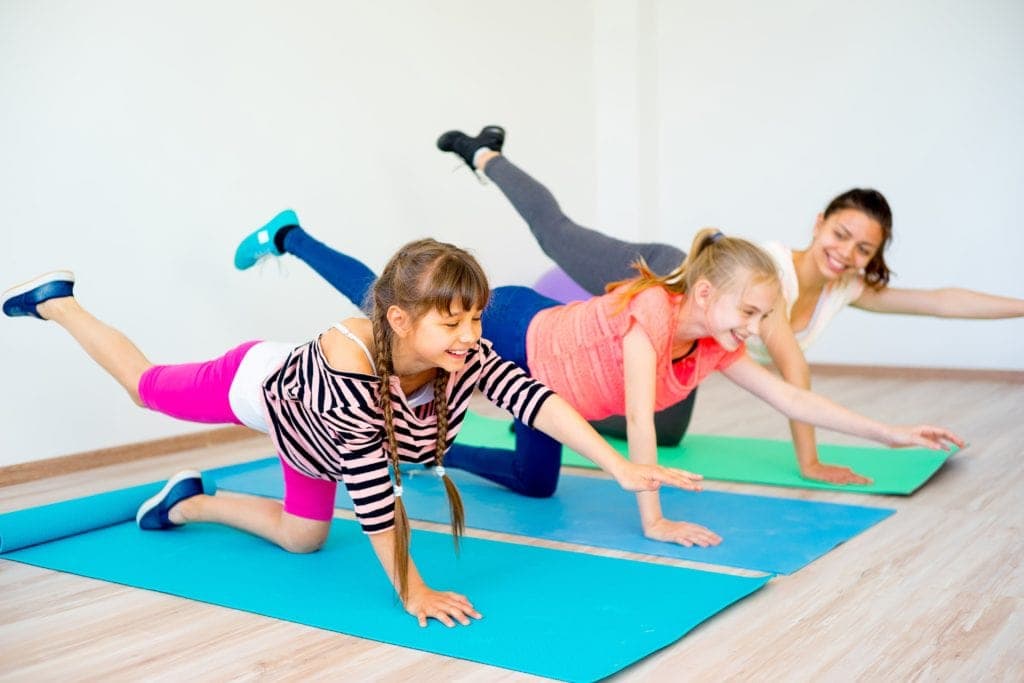
Why?
This age group often likes to play and explore with yoga poses as much as the 7 to 8-year-olds, but sometimes around 4th or 5th grade, they get a little more shy and embarrassed about their bodies (especially the girls).
For this reason, and more, it’s important to normalize that yoga is good for everybody and that ANYone can do yoga. I talk about how every body is different, that some things seem to be easy for some people and not as easy for others. But that it is ALL OK.
It’s also important for them to hear that yoga is an exercise that strengthens our bodies, keeps us flexible, and helps us get better at other sports (the boys often are less interested in stretching at this age, so you can talk about athletes that need to be flexible as well as strong).
What do they learn?
They continue to learn coordination and balance skills at this age, as well as more intricate instructions on correct positioning (if you think it’s appropriate! Form is hardly ever my focus unless they are being unsafe).
Most of my kiddos at this age (and in school) are becoming much more worried about social status and groups.
Many kids would rather talk and socialize, so use that to your advantage as best as you can.
Do some partner poses, let them play yoga games, we have some lighthearted competitions or challenges, and add in some more P.E.-based exercises (push-ups, jumping jacks, etc).
Learn to work as a team with games and poses. Many classes this age can be working on negotiating social issues: how to create a pose with someone, how to ask for permission when touching someone in a partner pose (consent!), how to win or lose a game with dignity.
These kiddos are at a great age to be talking about and learning the values of yoga philosophy.
What poses work best?
- As much as possible, keep the first part of the class focused on movement and a faster-paced sun salutation-type flow. Think vinyasa style, and focus less on form and more on getting them moving and not worried about how they look.
- You can add halfway lift to our sun salutation, as well as warrior 3.
- Low lunge and pyramid are great for increasing flexibility. Also, from pyramid, try standing splits, and sometimes “donkey kicks” (handstand hops).
- They love new balance poses like hot tree, figure four, dancer, side plank, wild thing, bridge, and even crow. Some kids can do handstands and arm balances, even shoulder stand, and headstand. But, make sure you are only teaching these if you know they have a strong core, and they are careful of their neck. (I don’t explicitly teach them these at school).
Savasana is attainable at this age as well, though it’s best to practice if they have more space to spread out so they don’t whisper the whole time. It’s ok to let them lay how they like (they are less comfortable flat on their backs) and it’s a good idea to try to talk them through a body scan relaxation so they notice how they are feeling personally.
Yoga for Teens Ages 12+
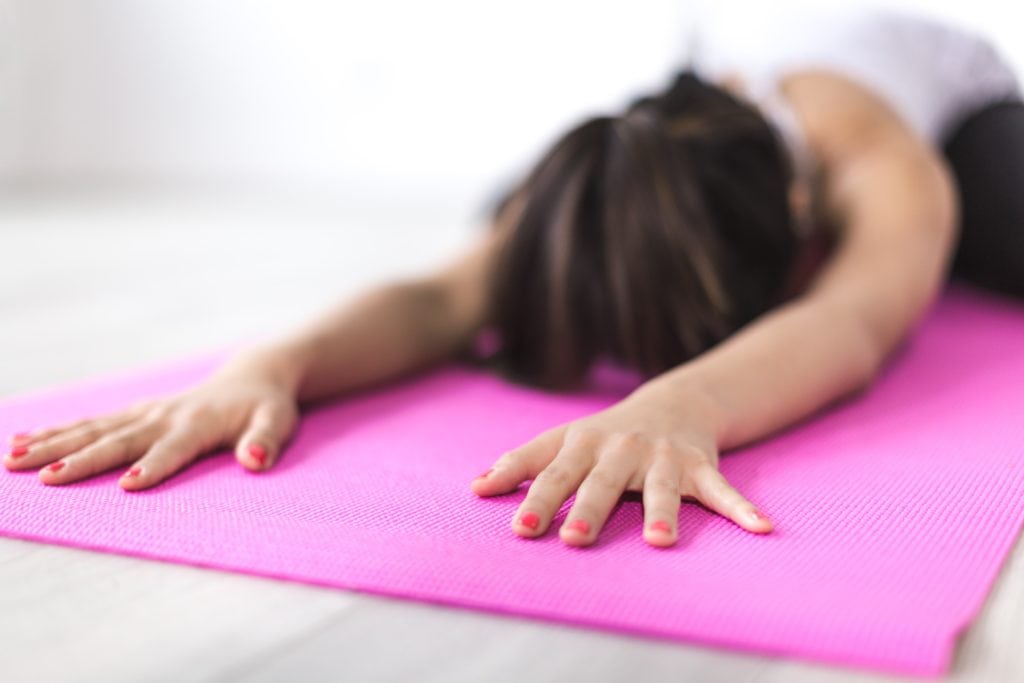
Why?
As with the previous group, this is an age in which social status and standing are becoming much more important.
They may be more worried about their bodies and therefore need SO MUCH encouragement that their bodies are growing and changing and that it’s OK to look and feel different. It’s important to be careful about how you talk about your own body around kids, but especially as they are older and their self-esteem is so at risk.
They need positive interactions with their bodies. They need to feel confident and capable, and they can get that with yoga when it is talked about encouragingly and with positive language. Try to talk about the things we CAN do, how we set realistic goals and being okay with changes from day to day.
What do they learn?
Kids at this age want to start doing classes a bit more like an adult. They want to experience yoga in the way they see others trying it.
If they really want to do yoga properly, they will want an adult-like class. Form and correct posture may be something they are trying to get perfect, but they will need to be reminded that yoga looks different for everyone. Body positivity and acceptance is CRUCIAL.
If they are not instinctively interested in doing yoga, you may need to encourage them by teaching them the real “Why” behind yoga. You can include more yogic philosophy, history of the practice, and how it really helps our brains as well as our bodies.
What poses work best?
- This is less of an issue in a studio setting, but in schools they may feel nervous about bending over, having their butt in the sky, and doing things that may look or seem juvenile or awkward. Unless you are able to be in a circle and know that they can handle it, try to avoid hands-and-knees poses like cat/cow, table top, etc.
- Sometimes poses on their stomachs are also uncomfortable for the same reasons.
- Basic Sun Salutations and Sun B are great for this age.
- Standing poses, balances, and some trickier poses like half-moon, three-legged plank, side plank to wild thing, are usually great to use in a sequence for these classes.
A sitting meditation if they have practiced mindfulness is a great option at this age. A longer savasana with a guided meditation on body positivity is something to work towards as they are able.
Hopefully, this post was helpful to you, in whatever way you use yoga for whomever you are doing yoga with.
Remember, this is just a basic guide. My experiences and the kids that I’ve worked with are obviously different from yours!
To learn more about it all, though, remember to check out the Ultimate Kids Yoga and Mindfulness Certification course here.
The most important part of teaching yoga to kids of all ages is to HAVE FUN. Don’t make it seem like work because then it just won’t work for anyone.
Check out some of my tips and tricks for teaching yoga to kiddos here! And enjoy the process. 🙂




